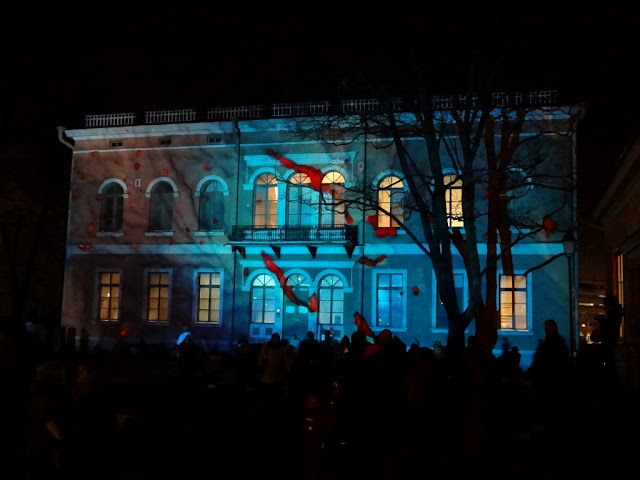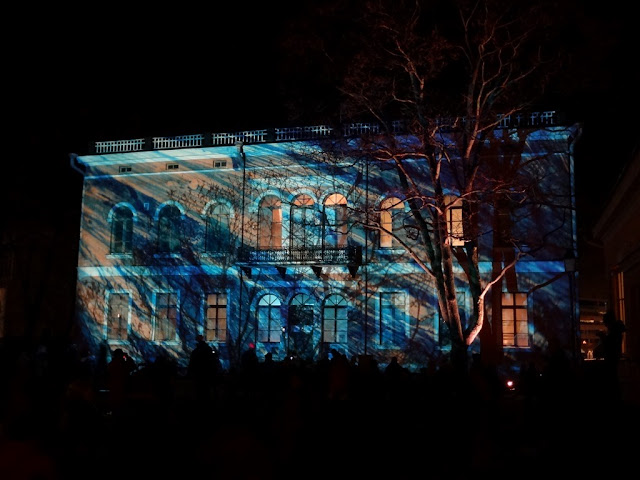If you ask me, the most fascinating
work at the recent Lux Helsinki 2014
event was a light installation called Edges
of Dreams. It was projected onto the facade of the Hakasalmi Villa, one of
the Helsinki City Museums that used to be a private residence.
The installation was created by Mika Haaranen, a lightning and set
designer and photographer, who had been inspired by the history of the pink
villa and its inhabitants. It was compiled of reflections of painted film and
shadow patterns with accompanying music composed by Aake Otsala.
The Hakasalmi Villa was built in the
1840s by a prominent Finnish figure and high official in the Grand Duchy of
Finland, Carl Johan Walleen. Today the building is only a stone’s throw away
from the very heart of the city but at that time it was a bit away from the
centre by the Töölö Bay, in other words practically in the countryside. The
villa, however, lost its access to the waterfront when the country’s first railroad was
constructed in the early 1860s.
During its 170 years, the villa has seen the surrounding town grow into a metropolis, not a large one in present-day standards but a metropolis anyway. It has also witnessed misery, such as the great famine of the 1860s plus a couple of wars but before all that it was part of the glamour and refinement of the aristocracy.
The building is still sometimes
referred to as the Karamzin Villa because of its best-known owner and last resident
Aurora Karamzin(a) born Stjernvall (1808-1902),
the stepdaughter of its builder. She was a Finnish noblewoman renowned for her beauty who
lived an amazing life that took her everywhere from the Emperor’s Winter Palace
in St Petersburg and villas and palazzi
in France and Italy to mining sites in the Ural Mountains.
To make a long story short, Aurora acted as a lady-in-waiting for the Empress of Russia; married a divinely rich Russian prince and imperial master of the hunt Pavel (Paul) Demidov; was widowed at the age of 31 with a baby boy; and as the guardian of her son suddenly had control over enormous assets.
Aurora’s husband died in 1840, which was the year she also lost her mother and one of her sisters. She needed to feel
at home and bought the family’s Träskända Manor in Espoo some 20 km out of
Helsinki from her stepfather. Incidentally, it was this transaction that provided
Walleen the means to build the Hakasalmi Villa.
Later Aurora married captain Andrei Karamzin; developed a serious interest in social issues, for example, starting social reforms at her late husband’s mines and foundries in the Ural; was widowed again at 46; and continued her social pursuits throughout the rest of her long life supporting and working for numerous charitable causes both in her homeland and abroad.
When travelling, Aurora used to
visit the local charitable institutions and hospitals to learn about their
activities. This was how she familiarized herself with nursing and the first ever
deaconess institute that was established in the Rhineland. In the 1860s, she
founded The Helsinki Deaconess Institute that is still very much active and highly valued
as an important non-profit foundation providing social, health care and educational
services.
The lavish lifestyle and self-absorbed
character of Aurora’s only child Pavel or Paul was a constant worry for her.
Paul died in Florence at the age of 46, 17 years prior to his mother. She lived her later years in the Hakasalmi Villa and left it to the City of Helsinki. For
more than a century now, the building has served as a museum, currently as the
City Museum with changing historical exhibitions.
Aurora Karamzin’s life was magical like a brilliant film plot. In fact, the Finnish director Maarit Lalli is preparing a script and filming is scheduled for 2015. The working title is ‘Le Grand Sancy’, which refers to the diamond of the same name, the 7th largest in the world that Pavel Demidov gave Aurora as one of the morning gifts. The diamond of 55.23 carats is believed to be of Indian origin but its history is known only from around 1570. It was sold to the Louvre museum in the 1970s by its last private owners, the British Astor family.
I very much hope Ms Lalli will manage
to raise the money required to make the kind of movie the extraordinary lady,
wonderful personality and pioneering philanthropist deserves.
(And I do hope Mr Haaranen will learn to use a proof-reader to avoid further annoying spelling mistakes. A live show does not draw your attention to such details, at least if you are watching from behind a maple tree, but photos are ruthless.)















That looks amazing, it was wonderful to experience it by watching the video too. It was so interesting reading about the story of the building too. What a shame it isn't still on the water front.
ReplyDeleteSarah x
The show was so magical I had to watch it several times. And the feeling of sharing such a special experience with equally enchanted strangers was also rather great. i can't wait what we'll see next January.
Delete